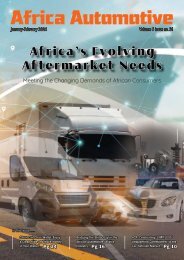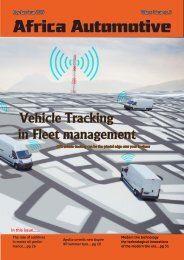Africa Surveyors November-December 2022 digital issue
Africa Surveyors is Africa’s premier source of Surveying, Mapping and Geospatial news and an envoy of surveying products/service for the Construction, Maritime, Onshore & Offshore energy and exploration, Engineering, Oil and Gas, Agricultural and Mining sectors on new solution based trends and technology for the African market.
Africa Surveyors is Africa’s premier source of Surveying, Mapping and Geospatial news and an envoy of surveying products/service for the Construction, Maritime, Onshore & Offshore energy and exploration, Engineering, Oil and Gas, Agricultural and Mining sectors on new solution based trends and technology for the African market.
You also want an ePaper? Increase the reach of your titles
YUMPU automatically turns print PDFs into web optimized ePapers that Google loves.
ENERGY
COP27: Kenya’s ambitious hydrogen deal &
plan to help Africa exploit green energy
Image: (L-R) Kenya President William
Ruto, FFI CEO Mark Hutchinson, Kenya
Foreign Affairs Minister Alfred Mutua
and FFI Executive Chairman Andrew
Forrest display copies of the Framework
Agreement at COP27 in Egypt. Photo:
Presidential Communication Service
By Tony Malesi
Kenya recently inked a deal with an
Australian firm to establish a green
hydrogen and ammonia plant,
kickstarting the country’s plan to utilise green
energy across the continent.
The industrial-scale production of green
hydrogen and ammonia will be vital in
making clean, affordable fuel and fertiliser
for Africa. Further, it will help Kenya, which
is already leading a geothermal revolution
across Africa, increase its footprint in the
renewable energy market.
Kenya’s deal with Fortescue Future Industries
(FFI), which has an expansive portfolio in
green hydrogen and renewable energy
projects worldwide, was signed on the
sidelines of the 27th Conference of Parties
(COP27) to the United Nations Framework
Convention on Climate Change in Egypt.
Kenya plays a leading role in the renewable
energy sector, with its geothermal capacity
(863 megawatts) ranked top in Africa
and seventh globally, according to The
International Renewable Energy Agency’s
Renewable Capacity Statistics 2022 report.
Kenya President William Ruto signed the
deal with the FFI Executive Chairman Andrew
Forrest. The company will set up an initial
300 MW green hydrogen and ammonia
plant in the next three years, which will
also produce fertiliser. The project will be
expanded in the future, with a target of
adding 25 MW.
Ruto said: "There is nowhere more crucial
for us to mark the public beginning of this
relationship than here at COP27 in Sharm
El-Sheikh, where we want to see actions
not words. Kenya is a leader of renewable
energy in Africa and we look forward to
the partnership with FFI to accelerate the
worldwide energy transition for the benefit of
the continent."
The multiplier effect of the hydrogen deal
will include job creation and boost food
security through its fertiliser production, said
Forrest. He emphasised FFI’s commitment to
helping Africa reduce reliance on fossil fuels.
The latest move has an estimated yearly
output of 1.7 million tonnes for export.
This will help Kenya join other continental
early adaptors like Nigeria and South Africa
to build Africa’s hydrogen and ammonia
capacity. United Nations Secretary-General
Antonio Guterres appealed to countries at the
ongoing COP27 to transition to green energy
quickly.
A considerable growth is expected in the
global ammonia capacity in the next five
years, with a possible increase to 284.21
million tonnes per annum (Mtpa) in 2025
from 230.88 Mtpa in 2020, according to the
latest report by GlobalData Plc, a British
management consulting company.
The FFI deal comes after yet another green
hydrogen partnership with the United
Kingdom, targeting to produce 30GW. These
deals are part of a broader strategy by Kenya
to help Africa transition towards green energy.
Approximately Kenya's 30 per cent installed
capacity is produced by independent power
producers, while 70 per cent is produced
by Kenya Electricity Generating Company
PLC (KenGen), a 70 per cent state-owned
enterprise, according to the Kenya-Electrical
Power System report.
Slightly over 70 per cent of Kenya’s electricity
is produced from clean / renewable energy
sources, according to the report. Of all these
sources, geothermal ranks first, even as the
country plans to wean itself off thermal
sources.
Kenya has significant renewable energy
potential due to the country’s strong solar
output, strong coastal breezes and favorable
geology in many other locations. The $690
million Lake Turkana Wind Power plant
(310 MW), for instance, is poised to be the
largest wind plant across the continent once
completed, the report added.
Kenya’s geothermal leadership is already
being felt across the continent, with KenGen
aiding various African countries to use green
energy.
KenGen, which has a market share of over 60
per cent in East and Central Africa, has also
recently won multi-million dollars in tenders
to drill hundreds of geothermal wells in
Rwanda, Ethiopia and Djibouti, among others.
“We desire that in the next couple of years,
we shall have a considerable presence
across the continent,” said KenGen in a press
statement earlier in the year.
President Ruto requested developed nations
at COP27 to invest in Africa to save the globe
from the adverse effects of climate change,
citing numerous opportunities.
“There are opportunities to produce 20GW
of wind power and 10GW of geothermal
electricity,” he said.
There is sufficient hydro-electric potential
in East Africa to generate 100,000 MW, the
President said. If properly exploited, this can
generate enough clean energy for Africa and
export, he told the delegates.
16 November-December issue l 2022 www.africasurveyorsonline.com

















